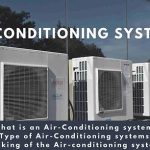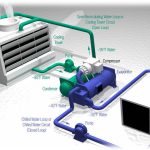Air conditioning systems can also be classified according to their construction and operating characteristics as follows.
Individual Room Air Conditioning Systems
Individual room, or simply individual air conditioning systems employ a single, self-contained room air conditioner, a packaged terminal, a separated indoor-outdoor split unit, or a heat pump. A heat pump extracts heat from a heat source and rejects heat to air or water at a higher temperature for heating. Unlike other systems, these systems normally use a totally independent unit or units in each room. Individual air conditioning systems can be classified into two categories:
· Room air conditioner (window-mounted)
· Packaged terminal air conditioner (PTAC), installed in a sleeve through the outside wall
The major components in a factory-assembled and ready-for-use room air conditioner include the following: An evaporator fan pressurizes and supplies the conditioned air to the space. In tubeand-fin coil, the refrigerant evaporates, expands directly inside the tubes, and absorbs the heat energy from the ambient air during the cooling season; it is called a direct expansion (DX) coil. When the hot refrigerant releases heat energy to the conditioned space during the heating season, it acts as a heat pump. An air filter removes airborne particulates. A compressor compresses the refrigerant from a lower evaporating pressure to a higher condensing pressure. A condenser liquefies refrigerant from hot gas to liquid and rejects heat through a coil and a condenser fan. A temperature control system senses the space air temperature (sensor) and starts or stops the compressor to control its cooling and heating capacity through a thermostat (refer to Chap. 26).
The difference between a room air conditioner and a room heat pump, and a packaged terminal air conditioner and a packaged terminal heat pump, is that a four-way reversing valve is added to all room heat pumps. Sometimes room air conditioners are separated into two split units: an outdoor condensing unit with compressor and condenser, and an indoor air handler in order to have the air handler in a more advantageous location and to reduce the compressor noise indoors.
Individual air conditioning systems are characterized by the use of a DX coil for a single room. This is the simplest and most direct way of cooling the air. Most of the individual systems do not employ connecting ductwork. Outdoor air is introduced through an opening or through a small air damper. Individual systems are usually used only for the perimeter zone of the building.
Evaporative-Cooling Air Conditioning Systems
Evaporative-cooling air conditioning systems use the cooling effect of the evaporation of liquid water to cool an airstream directly or indirectly. It could be a factory-assembled packaged unit or a field-built system. When an evaporative cooler provides only a portion of the cooling effect, then it becomes a component of a central hydronic or a packaged unit system. An evaporative-cooling system consists of an intake chamber, filter(s), supply fan, direct-contact or indirect-contact heat exchanger, exhaust fan, water sprays, recirculating water pump, and water sump. Evaporative-cooling systems are characterized by low energy use compared with refrigeration cooling. They produce cool and humid air and are widely used in southwest arid areas in the United States .
Desiccant-Based Air Conditioning Systems
A desiccant-based air conditioning system is a system in which latent cooling is performed by desiccant dehumidification and sensible cooling by evaporative cooling or refrigeration. Thus, a considerable part of expensive vapor compression refrigeration is replaced by inexpensive evaporative cooling. A desiccant-based air conditioning system is usually a hybrid system of dehumidification, evaporative cooling, refrigeration, and regeneration of desiccant.
There are two airstreams in a desiccant-based air conditioning system: a process airstream and a regenerative airstream. Process air can be all outdoor air or a mixture of outdoor and recirculating
air. Process air is also conditioned air supplied directly to the conditioned space or enclosed manufacturing process, or to the air-handling unit (AHU), packaged unit (PU), or terminal for further treatment. Regenerative airstream is a high-temperature airstream used to reactivate the desiccant.
A desiccant-based air conditioned system consists of the following components: rotary desiccant dehumidifiers, heat pipe heat exchangers, direct or indirect evaporative coolers, DX coils and vapor compression unit or water cooling coils and chillers, fans, pumps, filters, controls, ducts, and piping.
Thermal Storage Air Conditioning Systems
In a thermal storage air conditioning system or simply thermal storage system, the electricity-driven refrigeration compressors are operated during off-peak hours. Stored chilled water or stored ice in tanks is used to provide cooling in buildings during peak hours when high electric demand charges and electric energy rates are in effect. A thermal storage system reduces high electric demand for HVAC&R and partially or fully shifts the high electric energy rates from peak hours to off-peak hours. A thermal storage air conditioning system is always a central air conditioning system using chilled water as the cooling medium. In addition to the air, water, and refrigeration control systems, there are chilled-water tanks or ice storage tanks, storage circulating pumps, and controls
Clean-Room Air Conditioning Systems
Clean-room or clean-space air conditioning systems serve spaces where there is a need for critical control of particulates, temperature, relative humidity, ventilation, noise, vibration, and space pressurization. In a clean-space air conditioning system, the quality of indoor environmental control directly affects the quality of the products produced in the clean space. A clean-space air conditioning system consists of a recirculating air unit and a makeup air unit—both include dampers, prefilters, coils, fans, high-efficiency particulate air (HEPA) filters, ductwork, piping work, pumps, refrigeration systems, and related controls except for a humidifier in the makeup unit
Space Conditioning Air Conditioning Systems
Space conditioning air conditioning systems are also called space air conditioning systems. They have cooling, dehumidification, heating, and filtration performed predominately by fan coils, water source heat pumps, or other devices within or above the conditioned space, or very near it. A fan coil consists of a small fan and a coil. A water-source heat pump usually consists of a fan, a finned coil to condition the air, and a water coil to reject heat to a water loop during cooling, or to extract heat from the same water loop during heating. Single or multiple fan coils are always used to serve a single conditioned room. Usually, a small console water-source heat pump is used for each control zone in the perimeter zone of a building, and a large water-source heat pump may serve several rooms with ducts in the core of the building.
Space air conditioning systems normally have only short supply ducts within the conditioned space, and there are no return ducts except the large core water-source heat pumps. The pressure drop required for the recirculation of conditioned space air is often equal to or less than 0.6 in. water column (WC) (150 Pa). Most of the energy needed to transport return and recirculating air is saved in a space air conditioning system, compared to a unitary packaged or a central hydronic air conditioning system. Space air conditioning systems are usually employed with a dedicated (separate) outdoor ventilation air system to provide outdoor air for the occupants in the conditioned space.
Space air conditioning systems often have comparatively higher noise level and need more periodic maintenance inside the conditioned space.
Unitary Packaged Air Conditioning Systems
Unitary packaged air conditioning systems can be called, in brief, packaged air conditioning systems or packaged systems. These systems employ either a single, self-contained packaged unit or two split units. A single packaged unit contains fans, filters, DX coils, compressors, condensers, and other accessories. In the split system, the indoor air handler comprises controls and the air system, containing mainly fans, filters, and DX coils; and the outdoor condensing unit is the refrigeration system, composed of compressors and condensers. Rooftop packaged systems are most widely used .
Packaged air conditioning systems can be used to serve either a single room or multiple rooms. A supply duct is often installed for the distribution of conditioned air, and a DX coil is used to cool it. Other components can be added to these systems for operation of a heat pump system; i.e., a centralized system is used to reject heat during the cooling season and to condense heat for heating during the heating season. Sometimes perimeter baseboard heaters or unit heaters are added as a part of a unitary packaged system to provide heating required in the perimeter zone.
Packaged air conditioning systems that employ large unitary packaged units are central systems by nature because of the centralized air distributing ductwork or centralized heat rejection systems. Packaged air conditioning systems are characterized by the use of integrated, factory-assembled, and ready-to-use packaged units as the primary equipment as well as DX coils for cooling, compared to chilled water in central hydronic air conditioning systems. Modern large rooftop packaged units have many complicated components and controls which can perform similar functions to the central hydronic systems in many applications.



Comments are closed